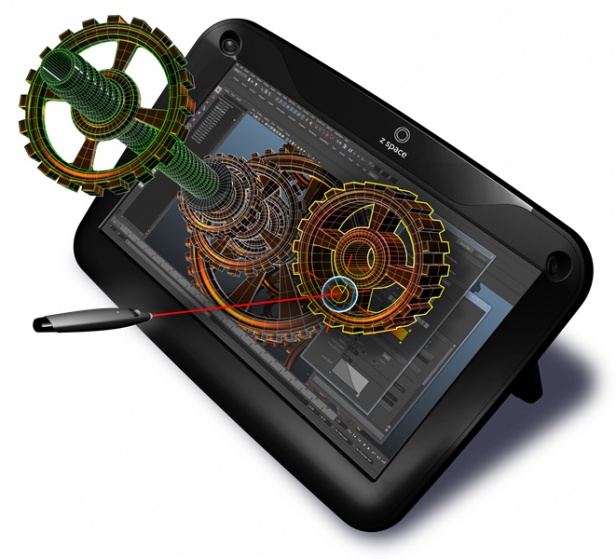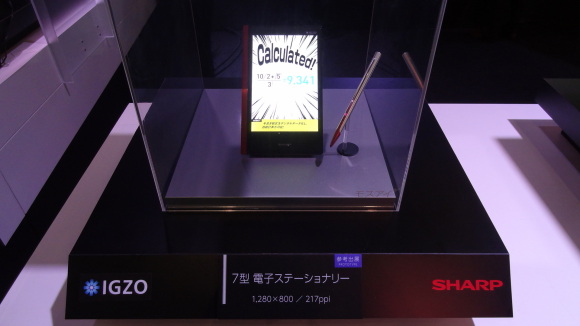Display Technology News Roundup 9.10.2013

Image via Qualcomm
Qualcomm Toq: The Anti-Galaxy Gear Smartwatch "Qualcomm has been working on its Mirasol technology for years. To date, it hasn't been very successful in winning adoption of the low-power screen tech. The Toq could change that. The Toq is probably the highest profile proof-of-concept Qualcomm could have created to show off its mobile screen cred. Thanks to the screen technology, Qualcomm says the Toq can go several days between charges." via InformationWeek
Research of highly rugged and lightweight liquid crystal displays "Together with national and international industry partners, scientists at the University of Stuttgart have started the development of very robust and extremely lightweight displays within the research project LiCRA. Instead of common glass substrates these displays are based on plastic foils what makes them flexible. The overall market for rugged displays is estimated to a total of seven billion (milliard) US$ until 2015." via Printed Electronics World
A Faster Liquid Crystal "The brightness of a pixel in a typical flat screen display is regulated by an electric field that controls the orientations of molecules of a liquid crystal. In Physical Review Letters, researchers report a much faster way of using the field to change the state of the molecules and alter the light transmission. Although the measured effect is small, it is thousands of times faster than the conventional technique and might be increased enough to allow new design options for displays." via APS Physics
LG Display Develops World’s First Intel® WiDi Enabled LCD Panel for Monitors "LG Display succeeded in developing a panel that provides Intel® WiDi solution by building in a key chipset directly into the LCD module. With this cutting-edge LCD panel embedded with Intel® WiDi solution, LG Display enables users to enjoy quality images with an easy and convenient access to Intel® WiDi technology without the use of additional devices, as well as facilitate OEMs and monitor makers nimbly and cost-effectively adopt this advanced technology." via LG Display Newsroom
Taiwanese take early lead in UHD LCD-TV panel market ""Most television brands are counting on UHD sets-with their astounding 3,840 by 2,160 resolution-to rejuvenate sales," said Sweta Dash, senior director, display research and strategy for IHS. "That's why the Taiwanese suppliers are focusing heavily on meeting early demand for UHD LCD panels. Meanwhile, South Korean suppliers LGD and Samsung have turned their attention to a different technology: the active matrix organic light emitting diode (AMOLED) panel, which they believe represents the next generation of television."" via CIOL
Display database for engineers Search thousands of display panels by multiple characteristics and compare results side-by-side using the display database multisearch.
Apple bucks the PC OEM trend and increases demand for LCD panels "In real terms, panel shipments in July totaled 14.9 million units, down from 19.3 million during the same month in 2012, claims a new report by IHS. ...Of the top panel buyers only one company increased demand, and that was Apple. According to IHS, the Cupertino company increased panel demand in order to be able to keep up with demand for the MacBook Air." via ZDNet
Gesture-based UI boosts proximity sensor market ""The Galaxy S4 from Samsung Electronics represented the first major push towards gesture interface capability in a handset when the smartphone was released this year," said Marwan Boustany, senior analyst, MEMS & Sensors, for IHS. "This is a step that others in the industry are likely to follow, thanks to the rising availability of gesture solutions from suppliers like U.S.-based Maxim Integrated Products and soon from both Japan's Sharp and Taiwan-based Capella Microsystems."" via EET India
Challenges involved in modernising an aircraft's avionics suite "For example, two H-model C-130 Hercules aircraft, originally built in the 1970s, and two stretch variants built in the 1990s, recently underwent extensive avionics modifications in Cambridge. At the heart of the programme was the installation of a Communications, Navigation, Surveillance/Air Traffic Management (CNS/ATM) compliant Flight Management System (FMS) and display and surveillance systems. The display system consists of six flat panel displays which incorporate the functionality of the many original electromechanical displays and the surveillance systems, including Enhanced Traffic Alert and Collision Avoidance System (ETCAS - which is mandatory for aircraft entering controlled airspace) and an Enhanced Ground Proximity Warning System. However, the aircrafts' original analogue autopilot systems had to remain, which meant employing signal converters so that old could interface with new." via New Electronics
Implications of passive stylus on large capacitive touchscreens "Passive stylus detection is a complex problem for touch engineers, with the root of the problem being the stylus paradox. The stylus paradox is that the signal profile for a passive stylus is several times smaller than that of a normal touch inut, but the fine point of the stylus makes the user believe that it will be more accurate. Accuracy and linearity are proportionally related to the signal to noise ratio of the system." via EDN
Do you have content to share with Display Alliance? Anyone can post press releases, white papers, commentary, videos, and more in the open section.
Two new features for electrophoretic displays? "The new Amazon Kindle Paperwhite will be the first product to incorporate Carta displays. Compared to Pearl, Carta promises higher reflectance and better contrast. What attracted my attention however was something that went completely unnoticed: on the specification sheet, E Ink now says an image update can be done in only 120 milliseconds." via Printed Electronics World
Researchers explore haptic technology beyond touchscreens "One of the critical challenges in developing touch systems is that the sensation is not one thing. It can involve the feeling of physical contact, force or pressure, hot and cold, texture and deformation, moisture or dryness, and pain or itching. "It makes it very difficult to fully record and reproduce the sense of touch," said Wang. As noted in the article, there has been significant progress on the development of flexible and sensitive pressure sensors, as well as tactile feedback displays for specific applications such as for remote palpation that could be used during laparoscopic surgery." Phys.org
When do interactive touchscreen displays make sense in the newsroom? "What most newsroom touch installations lack, is a clear vision of how this technology can be important for their audience. In many cases, engineers seem to have simply transitioned traditional on-air graphics onto a touch screen. Instead of some off-camera person triggering graphics on cue, the host triggers the graphics by touching points on the display. This can be pointless or profound depending on how it is implemented." via CGW
Are you an engineer or have display expertise? Email jason@displayalliance.com to be featured in the interviews section.
World-first smart fabric screen-printed electroluminescent watch display "The watch display is printed directly on to fabric to achieve the world’s first printed smart-fabric watch. The watch is printed layer by layer using screen-printable pastes with electronic functionality such as conduction, insulation and electroluminescence. The electroluminescent displays were printed by Marc using the thick-film printing facilities in the Southampton Nanofabrication Centre cleanroom." via University of Southampton
The LG G Pad will use GF2 display technology "One of the first manufacturers to use a film-based touch panel was Apple, on the iPad mini. According to the WSJ, the same tech will allow the Cupertino company to make the iPad 5 lighter and thinner than previous generations. If this report from Korea Herald is accurate, LG will benefit from the same advantages by using a GF2 film-based panel on the G Pad." via Android Authority
EU Adjusts Tariff On Flat Panel Displays "At present, a duty rate is applied on imports of flat panel displays not used exclusively for automatic data-processing (ADP). The reform will mean that displays using signals from ADP machines will be able to receive duty free treatment on an autonomous basis." via Tax-News
Optical touchscreens benefit from compact, high-power infrared LEDs "Optical solutions are now on the march, particularly for large displays. Their benefit lies in the excellent image quality because they do not need any special coatings that absorb a certain percentage of the backlighting. They can detect any type of pointer or stylus and even fingers in gloves because they are not reliant on the conductivity of these objects. Optical designs are also not at all sensitive to scratches and, depending on the power of the emitters, can be used for any size of screen." via LEDs Magazine
'Fake skin' computer touchscreen may aid cancer diagnoses "Ms Jess Tsimeris, of Bruce, is working with electromagnetic forces, using magnets to raise and lower soft latex surfaces. She has created soft touch surface with lumps that can be moved around and made firmer, or less firm. ...Supervisor Tom Gedeon said research in the field could also lead to more secure key pads at ATMS, using a squishy surface where a user was identified by how hard they pushed." via Canberra Times
Elon Musk demonstrates Iron Man style fabrication interface "Armed with a Leap Motion controller and few of today's mainstay 3D display technologies, Musk really has created something that roughly resemble's the interactive displays in Iron Man — though it admittedly looks like a Mark 1 model. In the video below, Musk takes you through the evolution of his interface." via DVICE
Apple researching display tech that can independently adjust appearance of UI elements "To efficiently recognize and change each element, the system looks at color saturation, or more specifically, saturated pixels versus non-saturated pixels. In one embodiment, the non-saturated pixels are associated with areas that don't hold active content, and therefore show the most change when display adjustments are made." via Apple Insider
What did you think about today's news? Leave a comment here and share your thoughts.
 News Roundup tagged
News Roundup tagged  Apple,
Apple,  Avionics,
Avionics,  Capacitive touch,
Capacitive touch,  E-paper,
E-paper,  Gesture recognition,
Gesture recognition,  LCD,
LCD,  LG,
LG,  Pixels,
Pixels,  Rugged display,
Rugged display,  Samsung,
Samsung,  TV,
TV,  Touchscreen
Touchscreen 



